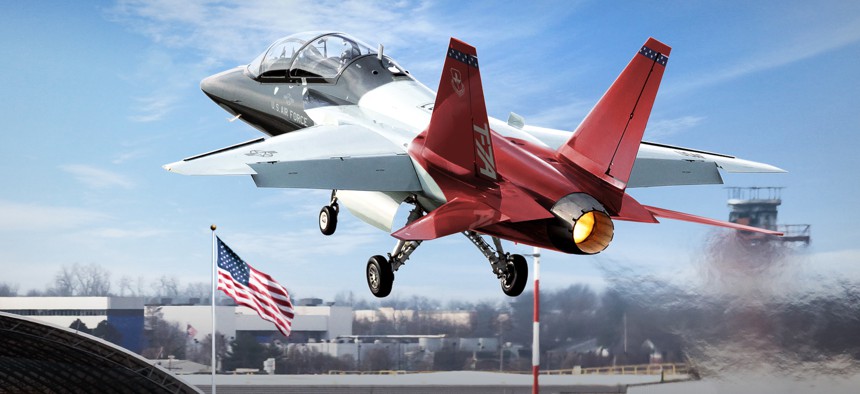
A Boeing T-7A takes off on a flight test. Boeing
Boeing’s Low-Ball Defense Bidding Has Come Back to Bite Them
The company has lost billions of dollars and the pandemic is making things worse.
In the fall of 2018, Boeing’s defense business was flying high. The company had just won three major Pentagon contests that were expected to bring in tens of millions of dollars over the next decade and beyond. That had followed a high-profile deal to build two new Air Force One jets, and while the job was not expected to be a money maker, it was a point of pride for the world’s largest plane maker and America’s largest exporter. All of the contracts carried some risk for the company, but executives expressed confidence in their products and the strategy they had used to win.
Now, nearly four years later, amid a global pandemic that has disrupted the supply chain, sickened workers, and led to the highest inflation in four decades, Boeing CEO Dave Calhoun has acknowledged that the company has lost nearly $1.5 billion on these programs.
A company director when the deals were made in 2018, Calhoun hinted that he has sworn off Pentagon contracts that leave Boeing on the hook for developmental problems.
“I will have a very different philosophy with respect to fixed-price development,” he said. “I don't expect and I hope never to contribute to that issue. But we are where we are.”
One of the main factors is a strategy used by then-Boeing executives who low-balled bids to win competitions and then signed risky Pentagon contracts. They gambled that even if Boeing lost money in the early stages of building new aircraft, it would make up for those losses with decades of sales.
The company placed aggressive bids in the three Pentagon contests: a competition to build new pilot training jets for the Air Force, a Navy deal to build an aircraft carrier-based drone that can refuel Navy jets, and an Air Force contest to supply helicopters for security teams that guard nuclear intercontinental ballistic missiles fields.
All three of those contracts, plus the $3.9 billion deal that Calhoun’s predecessor Dennis Muilenburg personally negotiated with former President Donald Trump for the two new Air Force Ones, were structured so that Boeing, not taxpayers, would be responsible for any cost overruns. A so-called fixed-price contract is risky for companies when a new weapon is in the early stages of development because unexpected hiccups inevitably arise—and they did.
Under Muilenburg’s watch, Boeing used this strategy to win four major competitions and the Air Force One deal. When he ran Boeing’s defense business, the company significantly underbid rival Airbus to win a competition to build 179 aerial refueling tankers for the Air Force. To date, the company has lost more than $5 billion on the project.
After Boeing won the trifecta of deals in 2018, Muilenburg said the wins demonstrated “the value Boeing brings to customers while positioning us well for future growth opportunities.” He called the projects “important future franchise opportunities” on an October 2018 earnings call.
The month after the three wins, Muilenburg singled out the training jet and the drone, acknowledging the company approached both competitions as it would when selling commercial airliners. The thinking was, if the U.S. military buys the planes, there’s a good chance that America’s allies would place their own orders down the road.
Not all were impressed. Marillyn Hewson, then CEO of Boeing rival Lockheed Martin, told investors that her firm would have lost “in excess of $5 billion” if it bid the three programs at Boeing’s price.
And the fixed-price contract is risky for companies when a new weapon is in the early stages of development, because unexpected hiccups inevitably arise.
“[T]here is significant uncertainty about the return Boeing can expect on this program,” Frank Kendall, who is now the Air Force secretary, wrote about the Navy drone in a September 2018 Forbes article.
From the Pentagon standpoint, signing a fixed-price contract is great for taxpayers, since the company must pay for any overages. It also motivates the company to deliver on budget.
Throughout the competition for the pilot training jet, Boeing touted how it, for the first time, fully designed a military jet with computers. The digital technology was supposed to lower the risk of costly redesigns down the road and allow the company to build the plane quickly.
The Air Force chose the Boeing plane over rival bids from Lockheed Martin and Leonardo, based on planes designed decades earlier, and signed a fixed-price development contract. Not only did Boeing bid low, but also spent millions of its own dollars building two T-7A prototypes that would prove out the new tech, which already put it in a financial hole.
“They were written off the day we took them, knowing that we would be investing a fair amount of our own money in the future of those airframes,” Calhoun said in reference to the T-7A and the Navy refueling drone. “I will tell you this: I think those are going to be really good bets.”
But there was something the company didn’t envision: COVID-19. Boeing revealed Wednesday that it lost $367 million on the T-7A due to supply chain problems, the pandemic, and increased inflation—problems that all also affected the broader economy.
“We got hit where you might expect us to get hit in a supply-constrained, still COVID-impacted, and inflationary world, and that is on a group of fixed price development contracts,” Calhoun said.
Calhoun said the T-7A financial losses are mostly due to the pandemic, not the engineering problems the company has experienced within its commercial programs.
“When we look at write-offs that we've taken, let's take this quarter, for instance, these fixed-price development contracts that we took were taken before COVID existed, and before this inflationary spiral came ripping down the road, so I don't attribute that to engineering shortfalls,” he said.




